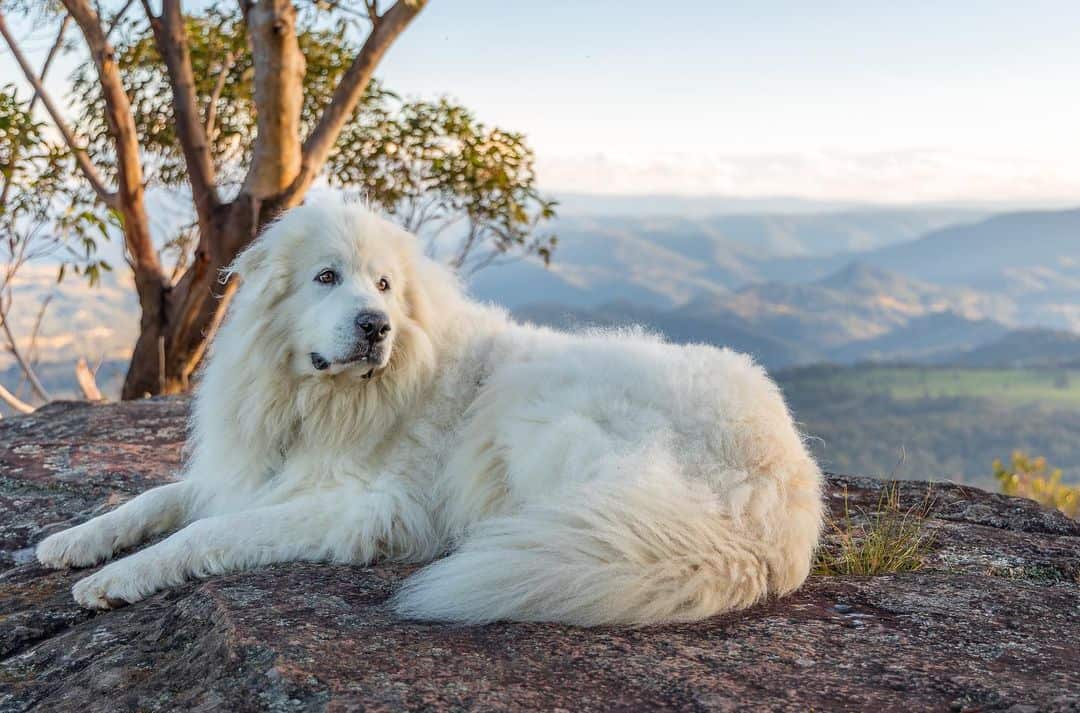The great Pyrenees are giant, but gentle dogs with thick, lush, white coats. The breed was named after the Pyrenees mountains that sprawl along the borders of France and Spain. That’s where these pups were first bred as sheepdogs.
They are sometimes also referred to as Pyrenean Mountain Dogs or just Pyrs for short. The French call them Patou.
The American Kennel Club currently lists this giant breed as the 63rd most popular dog in the United States.
If you are planning to adopt a Pyr puppy anytime soon, you will be wondering just how big these dogs get.
To help you out with that, we’ve created this handy Great Pyrenees growth chart that covers the Pyr’s height and weight throughout the various stages of its development.
Although they look massive and imposing, these dogs are actually gentle giants with a peaceful nature and loving temperament, which is exactly what has made them such popular family pets in recent times.
With this Great Pyrenees growth chart, you will be able to prepare yourself for everything that you will face during your puppy’s development.
So, without further ado, let’s get started.
Great Pyrenees Growth Chart
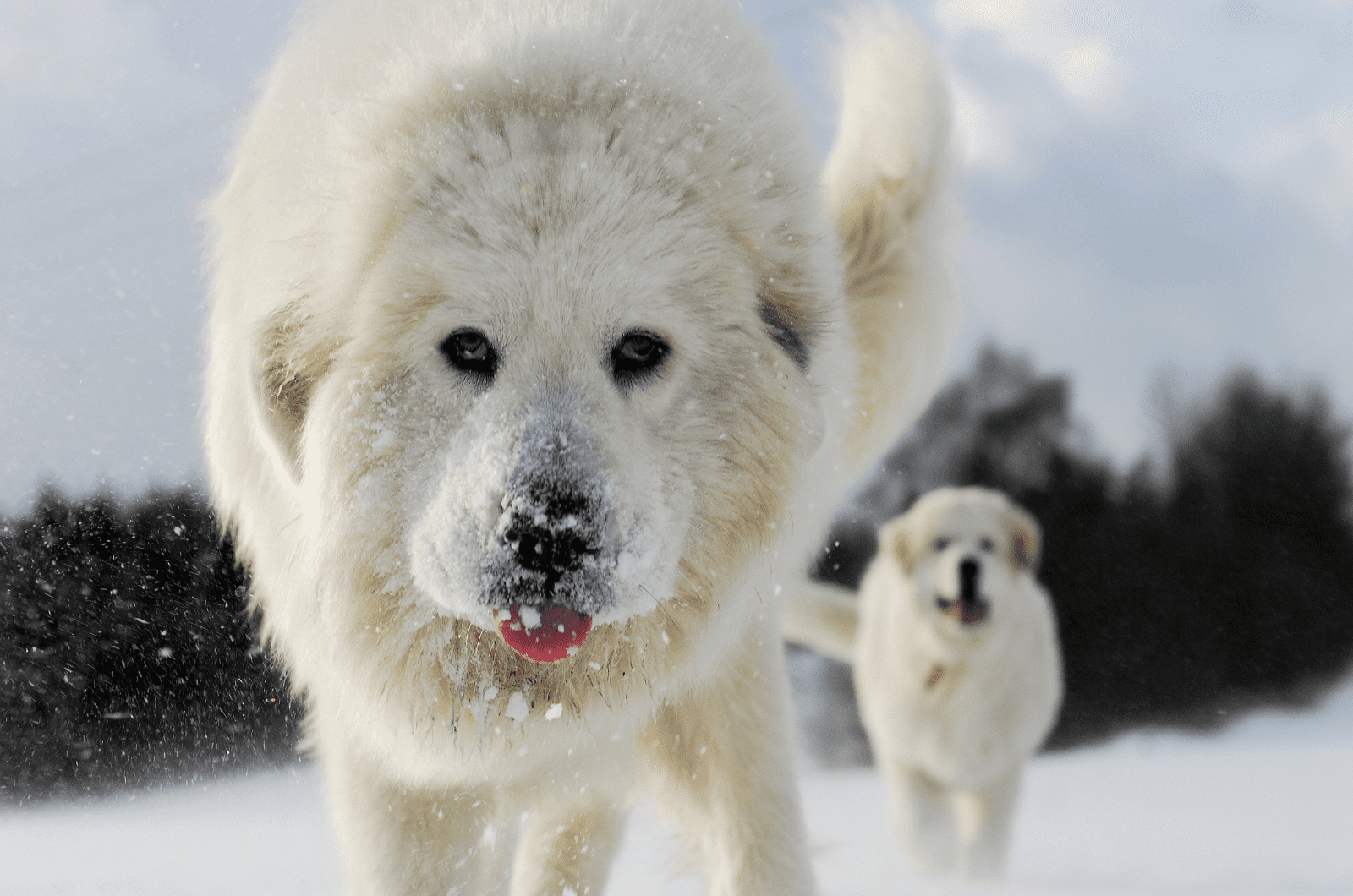
[table id=603 /]
Why Do I Need A Great Pyrenees Growth Chart?
Keeping track of a puppy’s growth during its formative months is one of the key parts of owning a dog. With a dog breed as huge as the Pyrenean Mountain Dog, that’s perhaps even more important, as it can surprise you just how much space they need.
With our Great Pyrenees growth chart, you will be able to stay on top of your Pyr’s growth and make sure that it’s on the right track when it comes to development. Cross-referencing the chart with your pup’s actual size and weight is an easy task that you can do regularly, to make sure there aren’t any irregularities.
But there is more to the Great Pyrenees growth chart than just that. Knowing how big and heavy your Pyr is supposed to be at any age can give you important reference points when it comes to planning its diet and living space, as well as your budget.
Large dogs eat a lot of dog food, but it’s not just about quantity. They require a healthy diet of quality food, especially if they are active and receive a lot of physical stimulation.
Owning a dog isn’t exactly a cheap experience. The average cost of a Great Pyrenees across its lifespan is close to $30,000, so anything that can help you cut some costs and plan your expenses better is a must-have addition.
The Great Pyrenees Puppy Development Stages
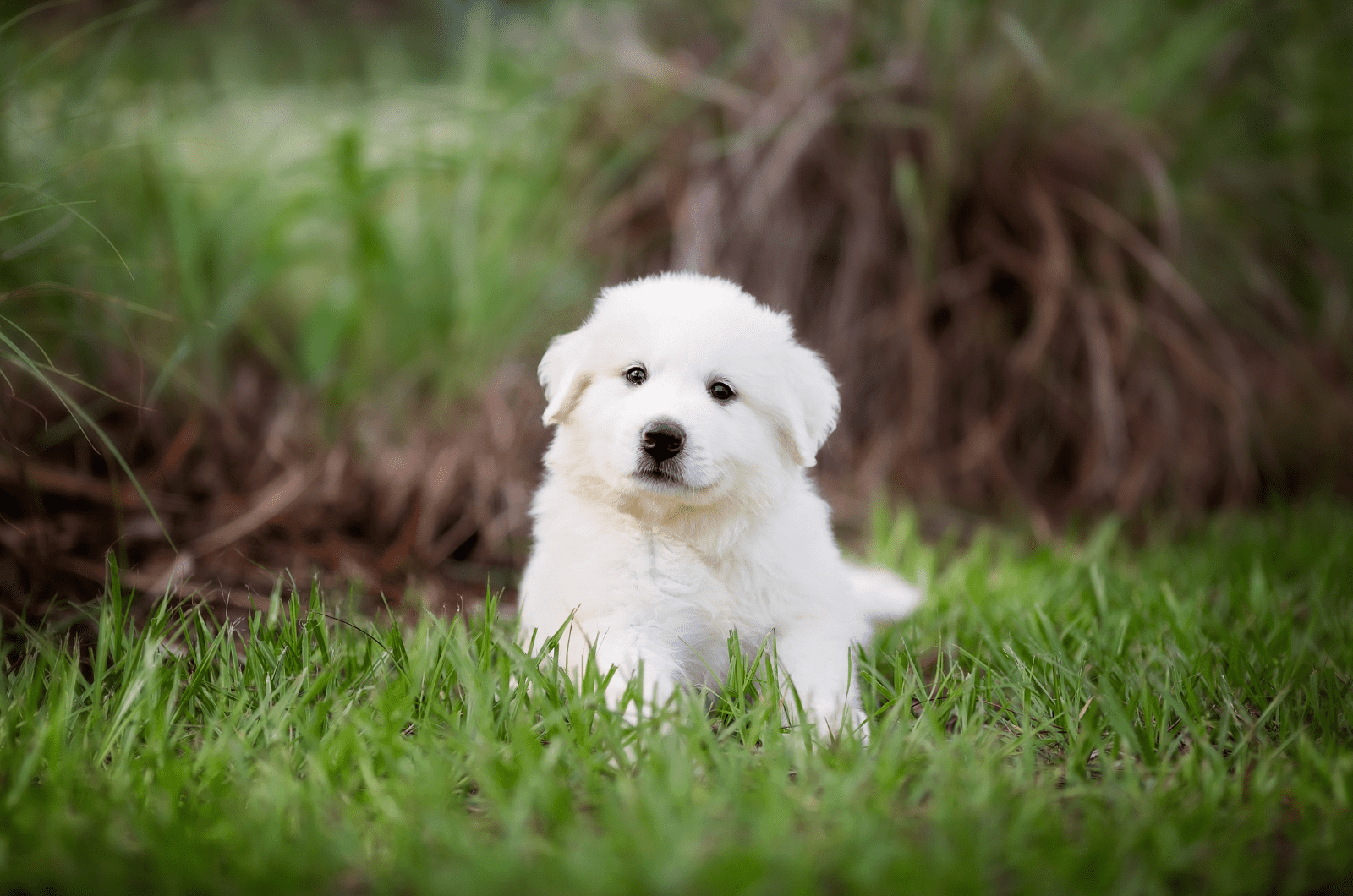
The Great Pyrenees puppy growth chart above is great when you want a quick overview of your dog’s expected size range. But what if you want more insight than that?
Then you should definitely read on because we’ve got some great information about each of the key growth stages that take place during a Pyrenean Mountain Dog’s puppyhood.
Basically, the first year and a half can be divided into different phases of growth. Each of those phases leads the puppy through different development milestones, both physical and mental.
Every single puppy is different, so the individual timelines will not always perfectly match this one, but it still makes for a great reference point for any dog owner that wants to put their Pyr’s development into context.
From Birth To Two Weeks
During the newborn phase, Pyrs are 100% dependent on their mother. They receive all their nutrients from her milk, and nursing is basically what they do for half of their time.
The other half is spent sleeping.
Their eyes and ears aren’t ready to do their jobs just yet, so the puppies are not really experiencing any of their surroundings in any meaningful way. They are still very vulnerable and fragile, not even close to being equipped to deal with the outside world.
When it comes to their size, they don’t resemble adult dogs at all. It’s hard to believe that a tiny ball of fur will end up being a proud, towering dog in just a few months. Great Pyrenees puppies usually weigh around one pound as newborns, but that triples by the time they are two weeks old.
There must be a lot of nutrients in that milk, right?
From Two Weeks To Four Weeks
This is a period of many new experiences for young puppies. Their senses start developing so they can start the socialization process.
They start hanging out and playing around with their siblings more, and they slowly expand their circle as time goes on.
Crucially, they start getting weaned off their mother’s milk for the first time towards the end of their first month. This switch to solid puppy food — or raw food if you prefer — will reinforce the rapid growth spurt they are experiencing and help them grow their little bodies into a more familiar shape.
Typically, male and female puppy weight will be about the same during this time, somewhere between five and ten pounds.
From Four Weeks To Three Months
The growth spurt continues throughout this period, with male Great Pyrenees usually reaching the weight of 15 to 30 pounds, and females 10 to 25 pounds, by the time they are three months old.
This is the first point in which we start to see the discrepancies in growth between male and female Great Pyrenees puppies. Those discrepancies will only continue to increase as time goes on.
Their body isn’t the only thing that is developing. They are starting to fully grasp their ability to hear and see, which helps them make new friends. They will explore their surroundings in a wider circle than ever before and become interested in all the living creatures around them.
They start developing their first relationships, other than their immediate family, and they start showing attachment to their owner. This is the first sign that you should slowly introduce them to the concept of training.
Start by teaching them some simple commands and rewarding them with treats. This will create a link between obedience and reward in their minds and make them eager to please in the future.
Start laying the groundwork in this early period and you will have an obedient, well-behaved dog by the time it reaches adulthood.
From Three Months To Six Months
If you take a peek at the growth chart, you will see that the Great Pyrenees will nearly double its body weight from the time it’s three months old to the time it’s six months old.
Male Pyrs will weigh an average of 70 to 80 pounds at the half-year mark, while females will be slightly lighter, with 50 to 60 pounds of body weight. A similar increase is visible in their height, as well.
This massive growth is followed by the strengthening of muscles and bones, which is absolutely necessary in order to support all of the newly added weight. The puppies might be a bit awkward during this time, as they are still trying to get used to all the changes in their body, so you will need to be extra careful and attentive with them.
Take good care when engaging them in any physical activity, as they are still probably not fully aware of how big and heavy they are. They don’t have complete control over their bodies yet, so they may injure themselves or somebody else if they get too excited.
You should also continue with the training sessions, making sure that you are always adding something to them so that you are teaching your pups something new at every chance you get. By the time they are six months old, they should have a steady routine consisting of diet, exercise, and training in their lives.
Having such a routine is vital for Pyrenean Mountain Dogs, as they like having something to fall back on.
From Six Months To One Year
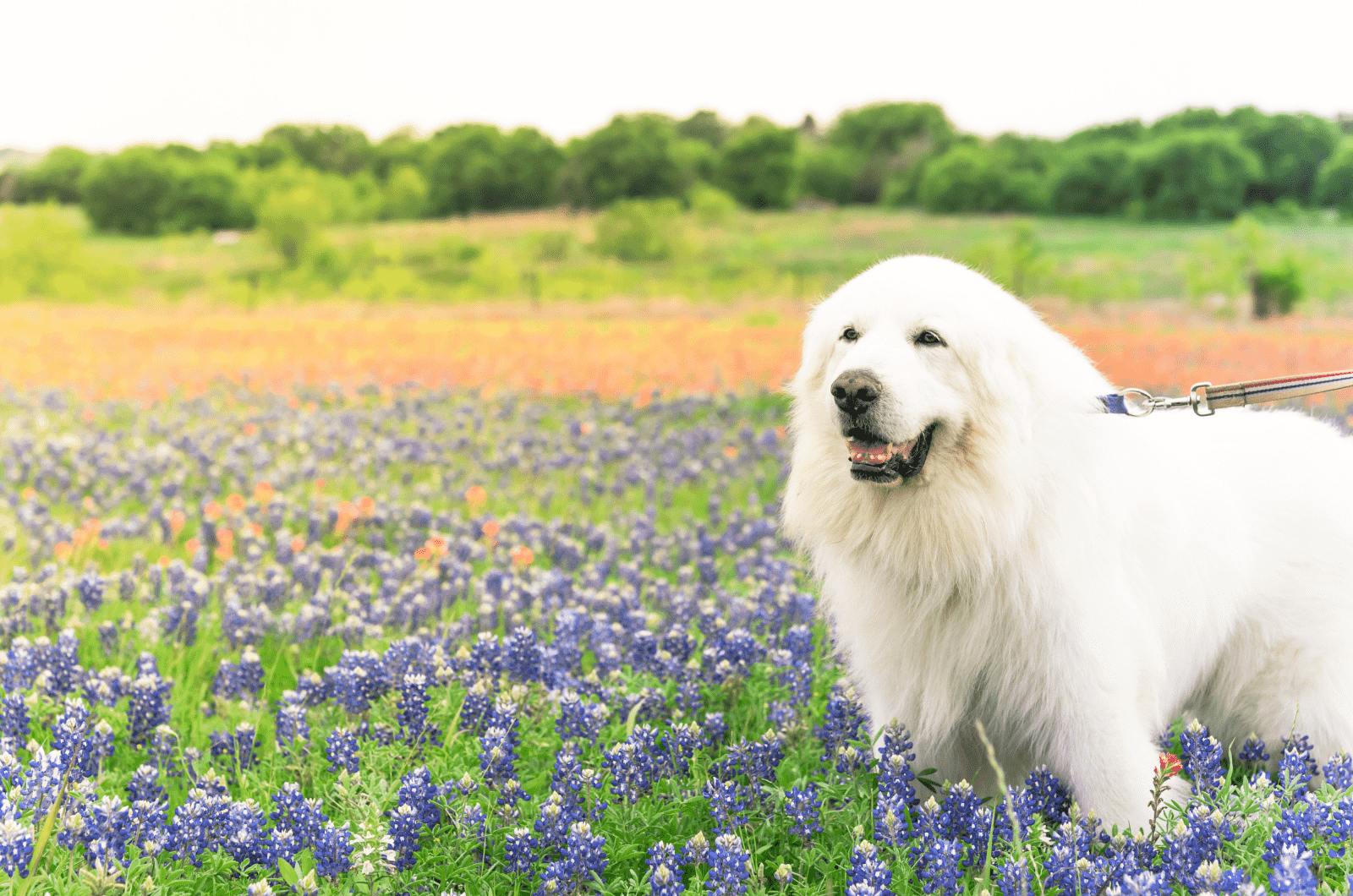
Before they blow out the candles on their first-ever birthday cake, Pyrenean Mountain Dogs will enter their adolescent phase.
Just like with human teenagers, this period is marked by big hormonal changes and the formation of their personalities.
Physical growth will continue, as you can see from the growth chart. Pyrs will add between 20 and 40 pounds to their weight in this six-month period, but that is not as shocking to their bodies as the previous periods were. This is because the added weight is mostly coming from further growth in their muscles and bones, their height is more or less settled at this point.
They are now much more accustomed to their bodies, but they are still developing their temperament and personality traits. If you have been patient and attentive with them up to this point, they should be extremely well-mannered dogs with a strong sense of family.
Differences between boys and girls are obvious by this point, Pyr males usually weigh between 100 to 115 pounds when they turn one year old, while females are still just below the 100-pound mark.
From One Year To Eighteen Months
During the period from twelve to eighteen months of age, your Great Pyrenees will only be experiencing some minor finishing touches in their physical development.
After your Pyr’s first birthday, its skeleton should be fully formed, its height at its maximum, and its muscles nearly completely formed. It can still add some weight, but it’s largely as big as it will get.
The healthy weight range of an 18-month-old Great Pyrenees is 100 to 125 pounds for males and 85 to 100 for females.
Adult Great Pyrenees
Fully grown Great Pyrenees are massive, imposing, incredibly powerful dogs that tower over most other breeds.
Male Pyrs stand at 27 to 32 inches tall at the withers, with their weight reaching up to 125 pounds at most. Females are a bit smaller, but they are still quite large when compared to other dog breeds. Their height is between 25 and 29 inches, and their weight maxes out at 100 pounds.
Pyrenean Mountain Dogs make perfect watchdogs due to their unique combination of strength, agility, grace, speed, bravery, and intelligence. But they are more than just guardians and watchdogs.
They are affectionate and kind toward their owners, other animals, and even strangers. They are always alert and protective, but they will never go rogue and attack someone without a reason. It is a truly majestic and elegant dog breed.
What Affects The Growth Of The Great Pyrenees?
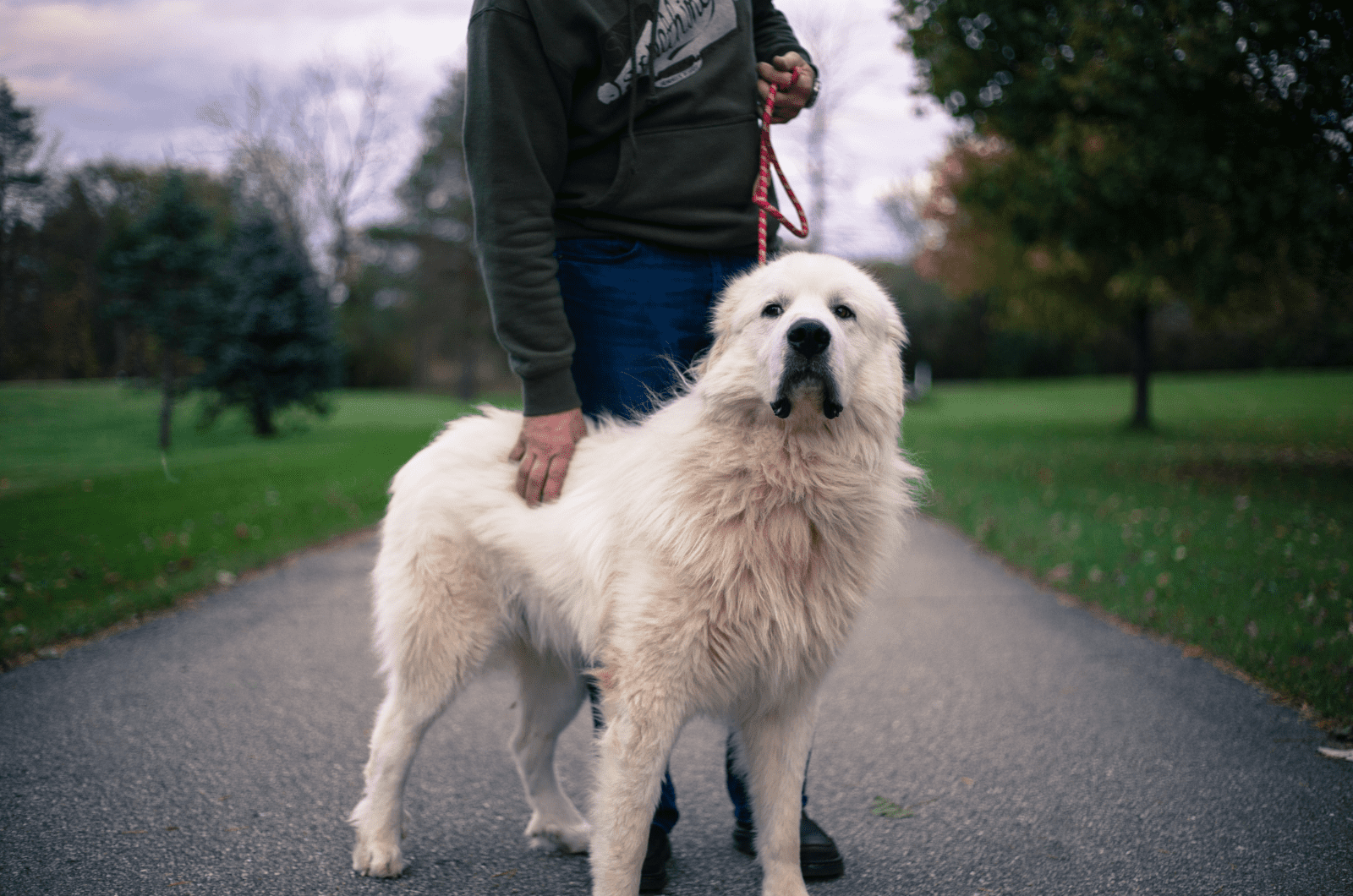
There is an amalgamation of factors that influence the final size of any dog. Sure, Pyrs are all massive dogs, but even among them, there are differences. Some are bigger and heavier than others, and it all depends on two distinct groups of factors — internal and external.
Internal Factors
Internal factors are something that every Pyrenean Mountain Dog is born with, and they are out of your control. You can’t really change a dog’s genetics or gender but knowing certain details about it can help you get ready for what’s to come and make sure that the puppy experiences the best possible conditions for its development.
Genetics
Genes determine a lot of the traits of all dogs, and all living beings in general. Great Pyrenees’ genetic makeup will dictate a lot of their characteristics and size, weight, and growth rate are definitely some of them.
If both of your Pyr’s parents were extraordinarily large, then you can probably bet that it will be above average in size, as well. The same goes for puppies with smaller parents.
If the two parents had a significant discrepancy between their size, for example, if the male was very large and the female was on the smaller side, then their puppies will generally be somewhere in the middle.
Of course, there isn’t a strict rule or an exact mathematical formula that will help you calculate your dog’s precise height and weight, but these guidelines will give you a great general idea. That’s why the growth chart contains weight ranges instead of singular weight values; you always need to leave some wiggle room.
Genetics play a big part in all of this, so it’s important for you to know as much about your pup’s ancestry as possible. The best way to find out is to ask the breeder about it because they will normally have all the pertinent genetic records available to them. Here is a list of some of the best Great Pyrenees breeders in the United States.
Apart from telling you a lot about your puppy’s expected size, those records can also ease your mind when it comes to a lot of genetically inherited health issues, such as hip dysplasia, for example.
Gender
We’ve already mentioned several times throughout the article that there is a significant discrepancy between the size of Great Pyrenees males and females.
It is a common occurrence in the animal kingdom for one gender to be bigger than the other, and in the case of canines, males are typically the larger ones. That fact is particularly true for Pyrenean Mountain Dogs, where the difference is very visible, due to the breed’s great size.
And these differences begin to show early on in the puppies’ development. Even at the age of five or six weeks, male pups will start to pull ahead of their sisters in terms of height and weight. By the time they’ve reached adulthood, the difference can increase to anywhere between 15 and 40 pounds in weight, and two to seven inches in height.
External Factors
External factors are consequences of a dog’s environment. These are the things that you can control, like the amount of food you give them and the level of physical activity you provide.
Nutrition and exercise are the two levers with which you can control your Pyr’s weight and keep it in check. There is no point in having a weight chart if you’re not doing anything to keep your dog within healthy parameters. Providing it with a quality diet and plenty of exercise are two ways to do that.
Diet
Great Pyrenees’ development is a steady process that lasts for months. If it’s not on the right track, i.e., if the pup is either too heavy or too light, that is usually a sign of an imbalanced diet.
Your Pyr needs a balanced diet full of protein and other nutrients that will serve as the fuel for its growth and development. You need to consider both the quality and quantity of the dog food that you serve to your pet.
It is a question of finding the balance and tweaking the amounts as the puppy ages. Generally, adult Great Pyrenees will eat between four and six cups of the best dog food that you can get every day, and it’s best if that is divided evenly across two meals, one in the morning and the other one in the evening.
Exercise
Regular physical activity is absolutely vital for any dog in order to maintain its weight, but also to keep it fit and healthy. However, there are many differences on a breed-by-breed basis when it comes to the amounts and intensity of exercising.
The Great Pyrenees aren’t considered a high-energy breed, so they don’t need to be running around all day to satisfy their needs, like a Terrier or a Poodle.
Two hours of moderately intense daily exercise should be ideal for your Pyr to maintain their fitness and tire out. But there is another aspect to it that needs to be considered with this breed.
Since they are guardians and watchdogs by nature, they have keenly developed senses and they are always on the lookout for potential danger. This means that they need a lot of mental and sensory stimulation to keep them happy.
So, if you’re taking your Pyr on a walk, try to adjust your route so that it includes vibrant areas full of interesting smells and sights for it to take in. In addition, make sure to keep a regular training routine as this will fulfill their needs for mental stimulation.
Great Pyrenees Growth Chart FAQ
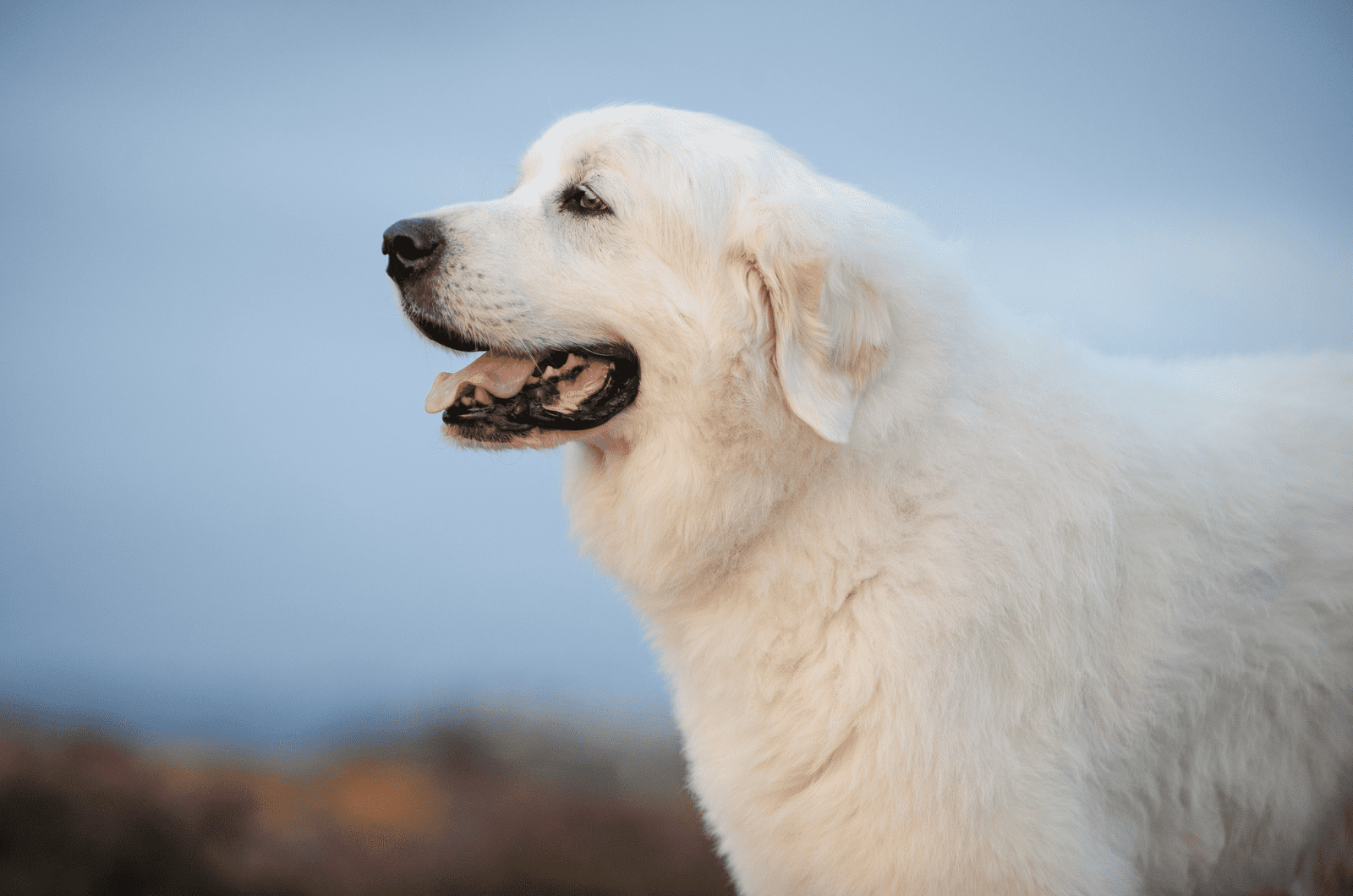
Hopefully, the Great Pyrenees growth chart, along with all the additional information we have provided in this article has given you a good sense of what to expect during your Pyr’s development.
However, there are still some questions that we have left unanswered. We have searched the internet for frequently asked questions related to this topic and decided to compile them all together in this section of the article. It’s great for easy access if you don’t have the time to read the whole article.
Along with the answers, of course. We’re not going to just list the questions and bail.
How Big Do Great Pyrenees Get?
Here are the ranges for the adult weight and size of Great Pyrenees, according to the AKC:
[table id=604 /]
If you’ve never actually seen a Great Pyrenees dog in person and you’re having trouble visualizing just how big it is, we’re going to give you some context by comparing them to some other famous big dogs.
For example, they’re much taller and heavier than Golden Retrievers who only reach about 24 inches of height at most and weigh no more than 80 pounds. So basically, a Pyrenees female dog is bigger than a Golden male dog.
Another breed that is significantly smaller than the Great Pyrenees is the German Shepherd. They max out at about 26 inches at the shoulders, and 90 pounds of weight, even though they look bulky and muscular.
Pyrs are about the same size as Great Danes, who also reach about 32 inches in height. However, full-grown Danes are slightly slenderer and rarely go over 110 pounds of weight. The recommended maximum Great Pyrenees weight is 125 pounds, but they can occasionally go up to 140.
This really puts into perspective what a giant dog the Great Pyrenees is.
When Will My Great Pyrenees Stop Growing?
Most of the Great Pyrenees, regardless of gender, reach full adult size and stop growing around the age of 18 months. However, some Pyrs develop a bit slower, and the process can sometimes last until they are two years of age.
Does Spaying/Neutering Impact The Growth Of The Great Pyrenees?
Fixing your dog not only removes its reproductive organs but also cuts off the supply of various hormones that stimulate and support growth, especially during the first year of its life.
If spaying or neutering isn’t done at the right time, it can cause these hormones to be out of balance. Since hormones are one of the main driving forces of growth, this imbalance can cause your Pyr’s development to be too slow or too fast.
If performed at the right time, spaying/neutering can be beneficial in many ways, including reducing the risk of cancer. The generally recommended time is between the ages of four and nine months, but you should always seek an expert opinion before making the decision to do it.
Once you do it, there is no going back, so it has to be a well-informed decision.
How Do I Know If My Great Pyrenees Is Overweight Or Underweight?
Because they are a large breed, Pyrenees have a bit more wiggle room when it comes to weight gain than small dogs, but that doesn’t mean that they can’t suffer from obesity or be underweight. It’s important to keep their weight within the recommended parameters.
Partly because of their naturally large size, and partly because of their fluffy coats, it can be hard to tell if your Great Pyrenees is overweight or underweight just by looking at it.
However, there are some methods that you can use to get a better idea even if you don’t have a scale at hand.
Touch Its Ribs And Spine
Trace your fingers along your Great Pyrenees’ spine and across its ribcage. You should be able to feel a thin layer of fat covering the muscles and bones below.
If you feel the dog’s spinal column, ribs, or tailbone under your fingers as you’re tracing along, that is a sign that the dog is underweight and needs to be put on a feeding regime that will increase its weight.
On the other hand, if you feel a layer of fat that is thicker than it’s supposed to be, meaning that you can’t feel the bone even if you apply some pressure, that means that the dog is overweight and could stand to lose a few pounds.
Soak Its Coat
The second method might be a little more challenging, depending on your Pyr’s discipline and relationship with water.
Pyrenean Mountain Dogs have long, thick, fluffy white coats. Not only do they shed a lot, but the coat also obscures the view of its actual figure, soaking it in water can reduce the volume of the hair and allow you to have a better look. After that, you inspect it visually and make a judgment call.
If you can clearly see the ribs, that means that the dog is definitely underweight and needs to bulk up. If you can’t see the ribs, then proceed with the touching method explained before, to make sure that the layer of fat isn’t too thick.
Final Word
The Great Pyrenees growth chart is a fantastic thing to have at your disposal if you own one of these amazing dogs. It’s something that can help you take care of your dog’s growth and development.
Tracking your Pyr’s growth is super easy, and you can do it any time you like. Simply cross-reference the weight chart with your dog’s actual weight and check if there is a difference. It makes diet planning so much easier when you know exactly what you should be aiming for.
But not only that, the growth chart can even help you take better care of your Pyrenean Mountain Dog’s health. Being underweight or overweight can sometimes be symptomatic of a more serious health problem, so if you notice it on time, you have a better chance of fighting it.
Read Next: Whippet Growth Chart — Is My Whippet Normal?
